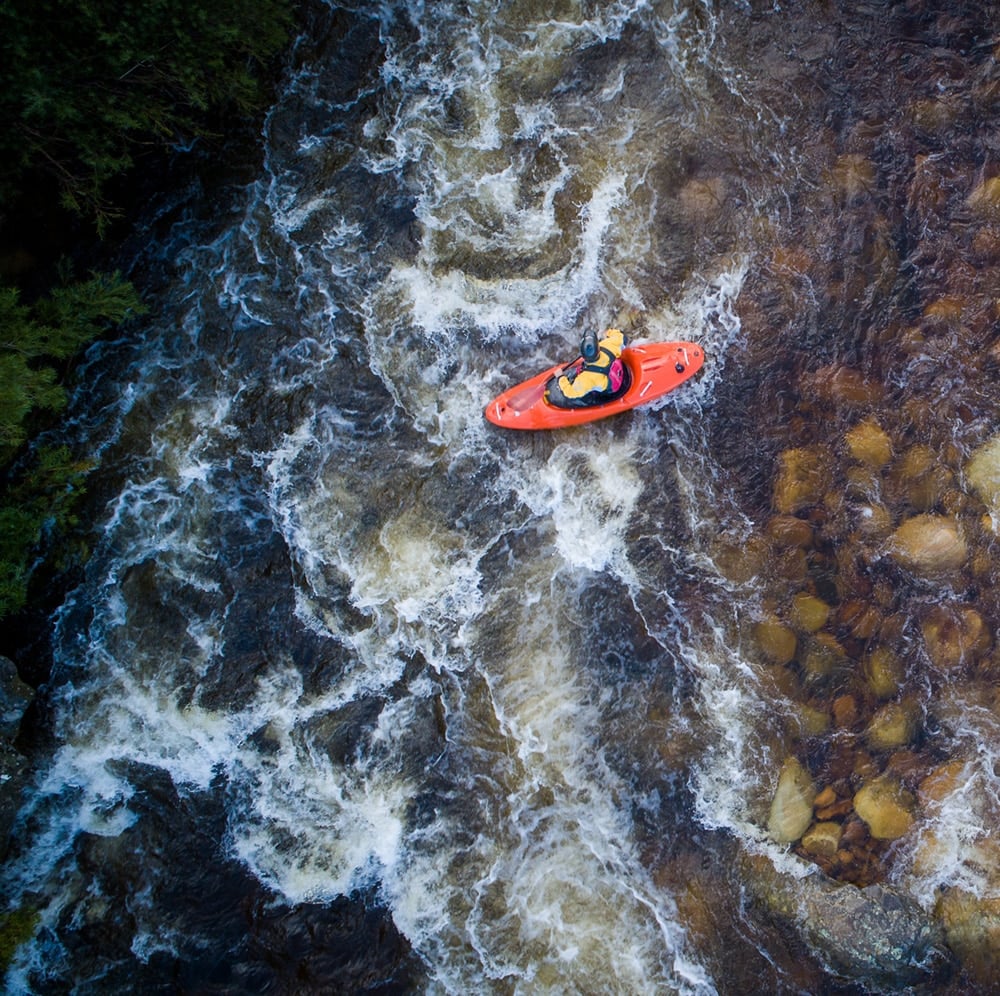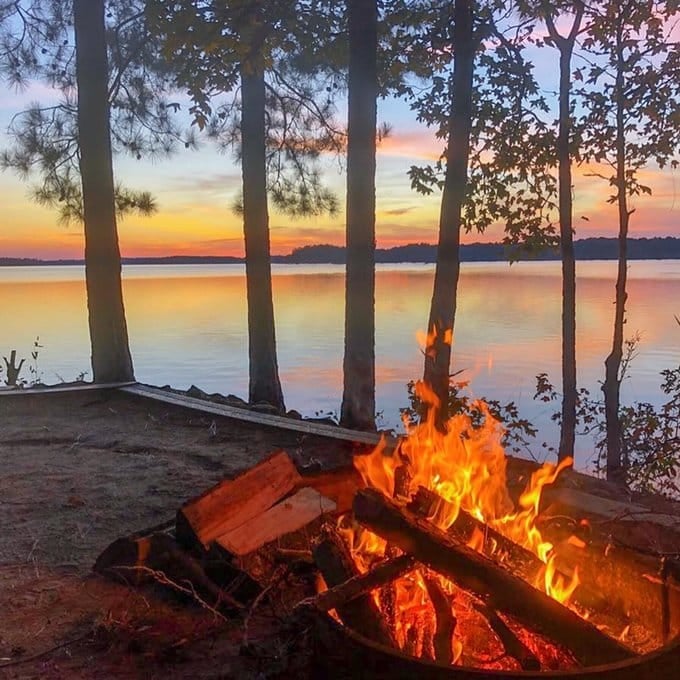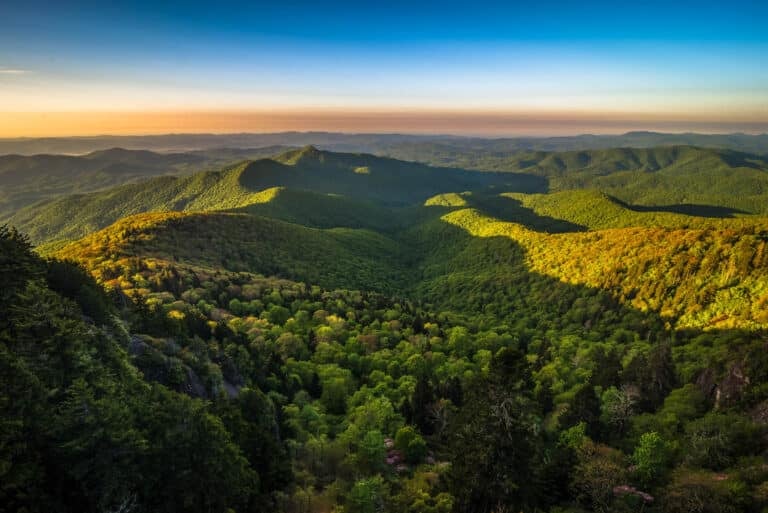There are few better ways to spend time in the great outdoors than cruising down whitewater rapids in your kayak.
However, whitewater kayaking is also a risky sport, requiring a high level of skill and expertise to manage risk on the river. Out of all the things that you need to know to paddle whitewater, learning how to kayak in rapids is arguably the most important when you’re just starting out.
Although there’s no substitute for time spent on the water and professional instruction, learning the theory behind how to kayak in rapids is essential before you make your first river descent. To get you started, here’s a quick guide to the basics of river running in a kayak.
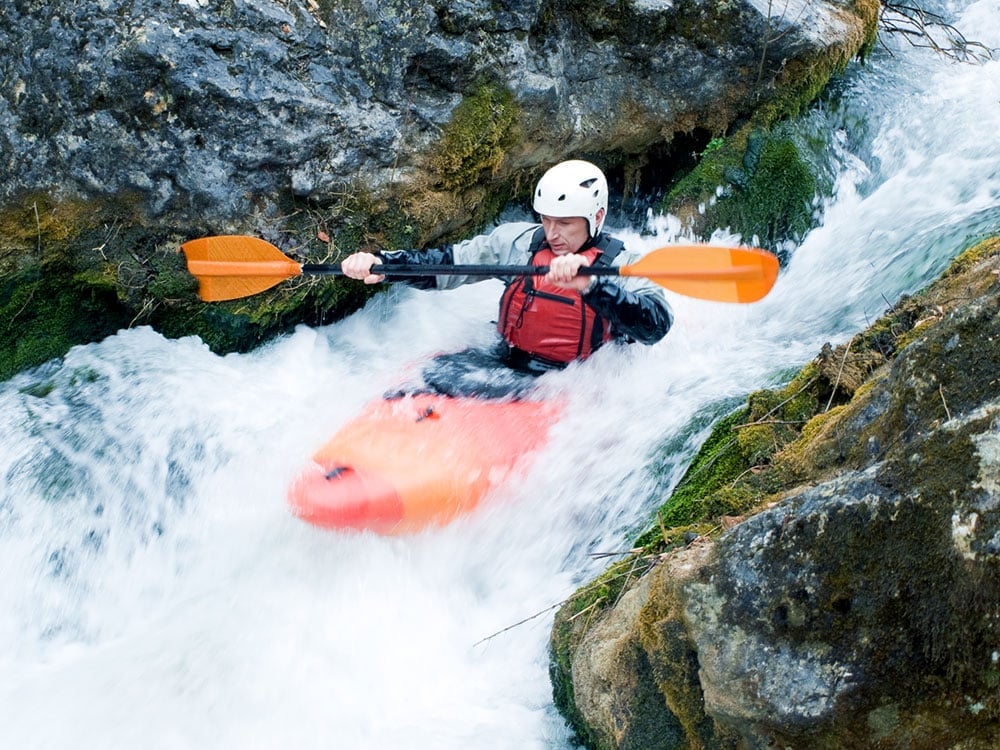
Whitewater Kayaking: The Basics & Safety Notes
Before we discuss how to kayak in rapids, it’s important that we cover some of the basics of whitewater kayaking.
First and foremost, anyone looking to paddle rapids should understand that rapids come in a wide range of difficulties. Rapids are classified according to their difficulty level using a rating system developed by the American Whitewater Association (AWA).
There’s a lot that goes into classifying rapids, but here’s a quick overview of the system:
- Class I – Relatively fast-moving water that has only a few small waves. Fairly casual paddling that poses minimal risk to kayakers.
- Class II – Slightly faster water with some mid-sized waves and a few rocks. Usually fairly wide with clear navigational channels.
- Class III – Intermediate river paddling with slightly larger waves. May have large hidden obstacles, strainers, and reasonably powerful currents. Relatively low risk of serious injury.
- Class IV – Advanced terrain with powerful rapids, large holes, strainers, big waves, and other hazards. Rapid scouting is highly recommended. Rolling skills required.
- Class V – Expert whitewater with very large and unavoidable rapids. Only suitable for experienced paddlers. High risk of injury in a swim.
- Class VI – Exploratory terrain with extreme conditions. Requires expert paddling skills and highly experienced rescuers on standby.
The whitewater classification system is important because it gives kayakers an idea of the risk involved with paddling a section of a river.
As a relatively new whitewater paddler, it’s essential to stick to lower-risk terrains, such as Class I and Class II rivers, until you’re confident in your ability to read and navigate rapids. Then, once you gain more experience and confidence, you can start to venture into Class III terrain to solidify your skills.
Additionally, always keep in mind that whitewater kayaking is an inherently risky pursuit. The risk of injury is low but still possible when paddling in Class I and Class II waters. Class III and higher rivers come with an even greater risk of injury and should be approached cautiously.
Therefore, always wear personal protective equipment, such as a helmet and PFD, while whitewater paddling. Paddle in a group and take whitewater rescue courses to learn the basics of river rescue. Seek out professional instruction and training to improve your skills. When in doubt, play it safe. The river will be there another day.
How to Read River Rapids
Learning to read river rapids is a foundational skill for any whitewater paddler. Without a well-developed ability to read the river, you’ll have a hard time navigating through tricky terrain. This may not be as big of a problem on lower-consequence rivers, but the ability to read a river will play a significant role in your ability to navigate large rapids.
In this section, we’ll go over a few key things to keep in mind as you learn to read a river. Some experienced paddlers can run Class I, II, and even III rapids without reading the river first.
However, as a new whitewater kayaker, it’s important that you stop to read rivers as much as you can. Even when it seems like overkill, stopping to scout a river whenever possible helps you hone and fine-tune your skills for when you start to encounter more significant terrain in the future.
What Is a Rapid?
The first step to learning how to kayak in rapids is understanding what rapids are and why they form.
Simply put, a rapid is the result of fast-moving water that flows down a steep gradient. The faster the water and the steeper the gradient, the bigger the rapid.
Of course, other factors go into creating a rapid. Other features, like constricting channels and obstructions, can also create rapids. Boulders, trees, and other debris in a river can all encourage rapid formation. Even if they don’t, they’re important obstacles that you’ll need to learn to spot and avoid at a moment’s notice.
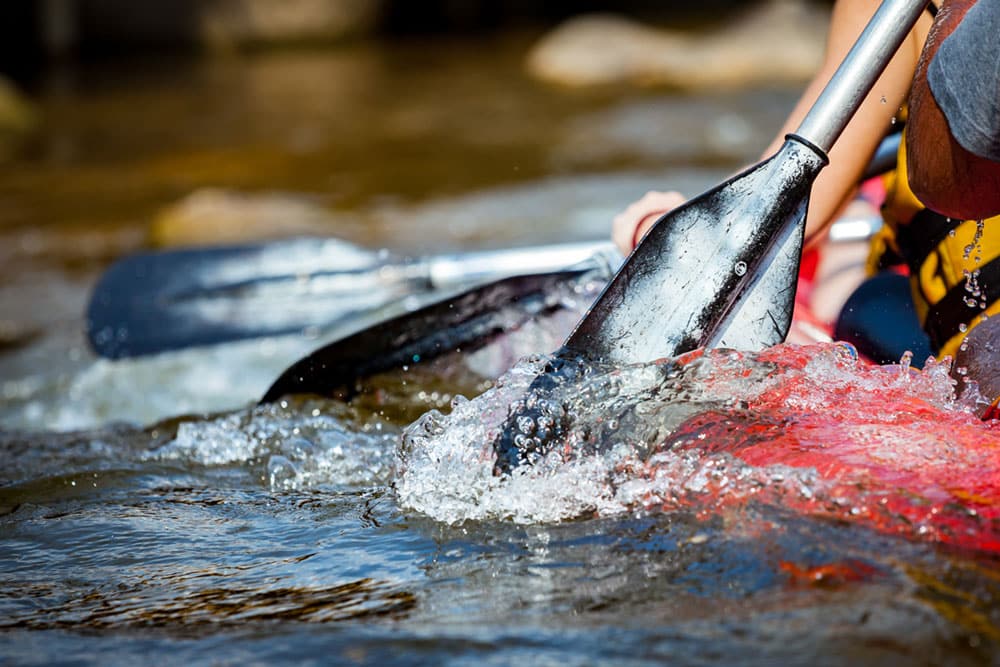
Major Rapid Features
There are many different kinds of rapids out there. Some are little more than a small wave, while others are gushing flows of water. Navigating each of these rapid types starts with understanding the different features that you should look for as you paddle.
Some of the key features you’ll see when reading a river include:
- Downstream V – Also called the tongue, the downstream V is often your best friend on the water. This looks like a steady flow of water that juts out downstream between two rocks or other obstacles. Following the downstream V usually means a smooth ride down the current.
- Upstream V – While the downstream V is a nice sight on the water, the upstream V isn’t so friendly. Upstream Vs form when water flows quickly around a rock. So, it’s important to avoid upstream Vs so you don’t go bow into a large rock.
- Eddies – An eddy is a location of relatively calm water that forms behind river obstacles. In eddies, water starts to swirl back upriver, reversing the water’s flow. These are often great places to take shelter from the river’s flow so you can scout the river or wait for your paddling buddies.
- Eddy Line – Eddy lines form on the edges of eddies where the eddy meets the river. Here, the water can get pulled in two directions, making entering the eddy or simply moving past it difficult. This usually isn’t much of a problem on Class I and II rivers.
- Horizon Line – If you see a horizon line in front of you on the river, you can generally expect that you’re approaching a sizable drop or ledge. In these situations, and especially in Class III+ water, you often need to scout the downstream river to see the terrain ahead before proceeding.
In addition to these features that you’ll notice while reading a river, you’ll also see a wide range of different obstacles on the water—most of which you should try to avoid at all costs. These include:
- Recirculating Waves – These waves form immediately downstream of a large object. They occur whenever water continuously flows back over itself, especially when there’s a sizable drop in the water level. Recirculating waves can be dangerous, and should generally be avoided. Often called holes, reversals, and stoppers.
- Standing Waves – A standing wave forms downstream of submerged obstacles. You often see more than one of them, especially in areas where the river rapidly narrows. Depending on the depth of the water, these can push swimmers under the surface.
- Buffer Waves – Buffer waves are the waves you see upstream of an obstacle, like a rock. They can clue you into the presence of obstacles that you should avoid. Sometimes called a pillow.
- Strainers – A strainer is a sizable object, like a tree branch, in a river that lets water flow through it. However, like your strainer at home, river strainers stop large objects (think you and your kayak) from flowing downstream. These are a significant hazard on the river.
- Whirlpools – Aptly named, whirlpools are areas in the river where the water whirls around and has a distinct circulation. Whirlpools can be very dangerous, but most small ones can be ridden out with relative ease. However, massive whirlpools should be avoided when flowing in full force.
- Siphon – A dangerous river feature that’s formed when water flows under a large rock. The water might be able to pass through easily, but kayakers usually can’t. Siphons can be hidden underwater, in which case they’re only detectable by comparing the inflow and outflow of water into the rapid. If there’s substantially less outflow than there is inflow, a siphon might be at work.
How to Navigate River Rapids
Regardless of what river you’re on, successfully navigating river rapids is all about picking a good line and sticking to it. Of course, this is easier said than done on Class IV+ rivers, but the navigation concepts you learn in more moderate terrain will serve you well in the long run as you venture into more extensive water.
Here are 4 top tips for navigating river rapids:
1. Follow the Downstream V
Unless you’re on the river for a bit of playboating, river running generally requires that you follow the downstream V as much as possible.
We’ve already discussed what a downstream V is, so we won’t belabor the point again here. But the idea is that following that tongue of smooth water that flows through two rocks or obstacles will often give you the nicest ride along the current.
Note that it can be challenging to spot the downstream V in very turbulent water. This is where scouting from your kayak or even scouting from shore can come in handy. In Class III and above terrain, it can be hard to find this downstream V when you’re already moving downriver very quickly. Don’t be afraid to stop and scout when necessary.
2. Consider Your Kayak’s Angle
As a general rule, it’s best to take waves bow-on rather than from the side. This is because taking a wave from the side of your kayak can cause the boat to capsize.
In very turbulent water, avoiding all side impacts with waves might be impossible. But in areas with isolated waves or features that are otherwise unavoidable, it’s best to face these challenges head-on.
Additionally, kayak angle also comes into play when you need to navigate around a series of obstacles. In these situations, the angle of your boat relative to the current direction or fall line is critical.
This is particularly vital to pay attention to when the downstream V wants to push you into a hazard, like a rock. When this happens, you may need to angle your boat so that your bow doesn’t directly lead down the current.
For example, angling the bow of your kayak to face your preferred direction can make it easier for you to avoid those downstream obstacles—even when the river wants to push you the other way.
3. Take it Slow
There’s an old adage that says that slow is smooth and smooth is fast. In whitewater paddling, these words are sage advice.
While whitewater involves paddling down fast-moving water, the speed of your kayak relative to the speed of the current actually shouldn’t be very fast. That’s because increased speeds on the water can make it very difficult for you to navigate around an obstacle.
Instead, try to approach rapids with a relatively low speed. Doing so makes it easier for you to navigate your kayak in relation to the current. Otherwise, you’ll get tossed around by the rapid and have little opportunity to steer as you flow downstream.
There are some instances where you need to build up a bit of speed on the river, but navigating through small to medium-sized obstacles generally isn’t one of them. So, go slow to go fast while on the river.
4. Master the Boof
The boof stroke is a critical skill for any aspiring whitewater paddler. Put simply, boofing is the act of preventing your kayak’s bow from getting pushed underwater. Boofing is particularly important over steep drops and waterfalls, but it’s also relevant when navigating other large obstacles.
Note that boofing can be very dangerous on large rapids and drops when done incorrectly. Therefore, be sure to practice this technique under the guidance of a skilled paddler before trying it on your own.
Since it can be so dangerous, boofing is one skill that you really can’t learn without hands-on practice. We’ll discuss the theory here, but practice and expert teaching is important.
With that in mind, the idea with the boof stroke is that it’s a powerful stroke often done at the top of a rapid. It’s designed to keep your bow from washing downstream, partially by changing the angle of attack of your kayak.
By doing a boof stroke on the downstream side of your kayak at the very top of a rapid, you can maintain your boat angle and avoid getting swamped. But again, this is an advanced skill that you can work up to as you gain more experience navigating rivers.
Happy Paddling!
Whitewater kayaking is one of the most exciting forms of paddling. From masterfully navigating your way through obstacles to the pure joy of cruising your way down a long river run, time spent on the river is always time well spent.
After reading this article, you have a solid understanding of the theory behind how to kayak in rapids. However, remember that theory is just one part of the equation. Be sure to get outside and on the river with an experienced paddler by your side.
Start with small rapids and relatively mild rivers and work your way up as you gain more skills and confidence. Over time, you’ll develop your ability to read rivers so you can take on more challenging terrain. See you on the water!

Cover photo courtesy of Getty Images
